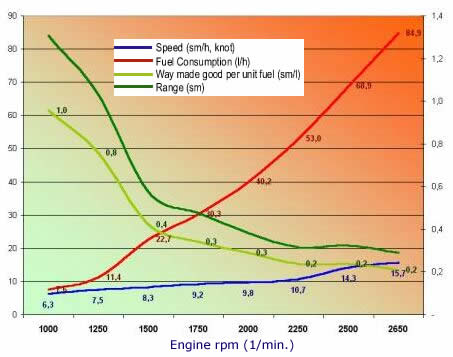With sample measurements on a Grand Banks 36 MY trawler
Data source: Powerboat & Motoryacht Magazine
We all know, we all hear, that consumption, range, noise and engine wear are strongly related to the engine revolutions. The data below show that these relations are beyond the imagination of most of us.
All what has been done is that a boat was run with varying engine revolutions and consumption, speed and noise were recorded.
|
Revs (1/min)
|
Speed (sm/h,knot)
|
Consumption per time unit (l/h)
|
Way made good per unit fuel (sm/l)
|
Range (1000sm)
|
Noise (dB)
|
|
1.000
|
6,3
|
7,6
|
1,0
|
1,31
|
73
|
|
1.250
|
7,5
|
11,4
|
0,8
|
1,03
|
73
|
|
1.500
|
8,3
|
22,7
|
0,4
|
0,58
|
74
|
|
1.750
|
9,2
|
30,3
|
0,3
|
0,48
|
75
|
|
2.000
|
9,8
|
40,2
|
0,3
|
0,38
|
77
|
|
2.250
|
10,7
|
53,0
|
0,2
|
0,32
|
78
|
|
2.500
|
14,3
|
68,9
|
0,2
|
0,32
|
79
|
|
2.650
|
15,7
|
84,9
|
0,2
|
0,29
|
80
|
1. Speed of the vessel is the variable least depending on engine revs. When the engine revs are 1000-1 speed is 6.3 knots. When the engine is revved up to 2650-1 , the speed has increased to 15.7 knots.
2. Range, way made good per unit fuel and hourly consumption are highly dependent on the engine revs. As an example, while at 1000-1 revs the hourly fuel consumption is 7.6 liters. At 2650-1 revs this has increased to 84.9 liters. Thus, the hourly consumption has increased more than TEN fold. At the same time, range and way made good per unit fuel has decreased FIVE fold.
At this example the “good” revs are 1500 – 1750 revs. Specially the green curves show the “hump” at these revs. Above these revs the range drops more significantly.
In summary, whoever runs his/her engines calmly, reduces engine wear, saves money and has the comfort of a larger range. Whoever “beats” the engines harm the environment and themselves..
|
Notes: |
|
|
|
[1]Original tables from PMY magazine
|
|
rpm
|
Sea Mile/Gallon
|
Speed(Knot)
|
Gallon/Hour
|
Sea Mile / Gallon
|
Range
|
Noise(dB)
|
|
1000
|
7.3
|
6.3
|
2.0
|
3.63
|
1308
|
73
|
|
1250
|
6.6
|
7.5
|
3.0
|
2.87
|
1032
|
73
|
|
1500
|
9.6
|
8.3
|
6.0
|
1.6
|
576
|
74
|
|
1750
|
10.6
|
9.2
|
8.0
|
1.3
|
477
|
75
|
|
2000
|
11.3
|
9.8
|
10.6
|
1.1
|
382
|
77
|
|
2250
|
12.3
|
10.7
|
14.0
|
0.9
|
316
|
78
|
|
2500
|
16.4
|
14.3
|
18.2
|
0.9
|
324
|
79
|
|
2650
|
18.1
|
15.7
|
22.4
|
0.8
|
290
|
80
|
| Boat | Grand Banks 36 MY | Test Conditions | |
| Length OA | 11.23 m | Temperature | 21 ºC |
| Beam | 3.86 m | Humidity | %85 |
| Fuel Capacity | 1515 l | Wind | No wind |
| Draft | 1.22 m | Sea Condition | Very Calm |
| Displacement | 12.2 ton | Fuel | ½ capacity |
| Engines | Dual 210-hp Cummins 6B15.9M | Water | Full |
| Transmission | Twin Disc MG 5050 2.54:1 | Crew | 3 |
| Propellers | 28”x25” 3-blade bronze | Load | Light |
The speed has been measured as average of two direction by radar.
Source: Powerboat & Motoryacht, January 1996, page 92


 Turkish
Turkish Deutsch
Deutsch Русский
Русский